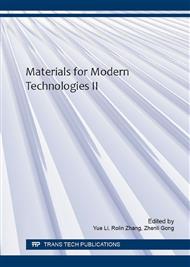p.3
p.8
p.13
p.18
p.24
p.30
p.39
p.45
p.50
The Effect of Excess Sodium Element on KNN-BF Piezoelectric Ceramics
Abstract:
Lead-free (K0.5Na0.5)0.992Nb0.992-0.008BF-xNa (KNN-BF-xNa) piezoelectric ceramics with excess Na doping were synthesized using the sol-gel method at the sintering temperature of 1100°C. The effects of excess Na-doping on microstructure and properties of the lead-free piezoelectric ceramics were systematically investigated with x from 0.00 to 0.04. As x increased into 0.03, the acutest peak of x-ray diffraction patterns appeared; the SEM fig.1(c) showed regular and dense crystal shape. KNN-BF-0.03Na ceramics showed excellent properties of d33=149pC/N, εr=641(f=1KHz), tanδ=0.06(f=1KHz), ρ=4.15g/cm3. The results indicated that excess Na doping can make up for the Na volatilized while sintering under atmosphere pressure, but as x was 0.04, too much more Na dropping would lower the sintering temperature. Therefore, there would be quantities of liquid phases, as was shown in the fig.1(d), which caused the inferior properties of piezoelectric ceramics.
Info:
Periodical:
Pages:
24-29
Citation:
Online since:
May 2016
Authors:
Price:
Сopyright:
© 2016 Trans Tech Publications Ltd. All Rights Reserved
Share:
Citation:


